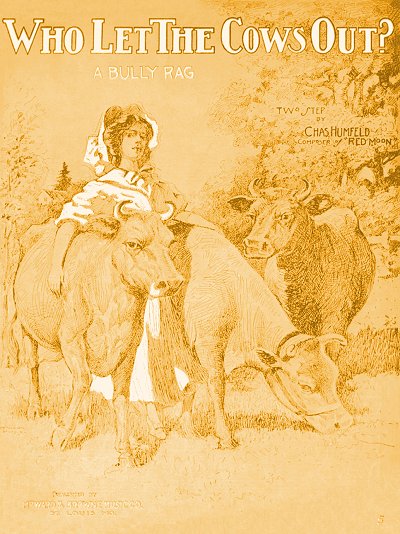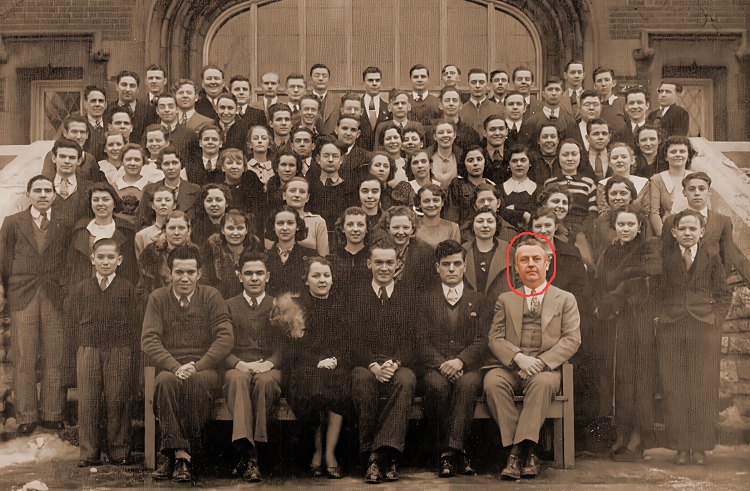|
Charles August Humfeld (October 18, 1891 to February, 1967) | |
 Compositions Compositions | |
|
1908
Red Moon: Intermezzo1909
Red Moon: Song [1]1910
Who Let the Cows Out: A Bully RagI Am For You [2] 1912
That Left Hand Rag1914
Humpy's Buck |
1915
When You Buy Me a Ford (I'll be Readyto Marry) [3] 1930
His Majesty: Theme March1942
Let's Go
1. w/Eddie Dustin
2. w/Janet Adler 3. w/Lawrence Lewis |
Charles Humfeld was born in the same general vicinity as Scott Joplin, in Texarkana, Texas. His parents were German immigrant cook August H. Humfeld and his Indiana-born wife Mary Jane "Mollie" Cannon. One older sister, Mary Idella "Ida", was born in 1877 and his brother Leo in 1879, and died in the 1880s. While August and Mary Jane were married in Saint Louis, Missouri, and their first two children were born there, they had moved to Texarkana briefly where Charles was born, then at some point in the mid-1890s moved back to Saint Louis. Over the coming decade that storied city would become a hotbed of ragtime activity.
As of the 1900 census taken in Saint Louis, the Humfeld family was living on North 6th Street, just a few blocks from the river and in the heart of downtown. While it was not directly near some of the black entertainment districts, it is possible that Charles may have accompanied his father, a head cook at a local hotel, to his job where some live music was often performed. It also was not that much of a stretch in 1904 for the family to have ventured out on the trolley to the Lewis and Clark Exposition,  where 12-year-old Charles might have been drawn to the fair's Entertainment Pike, a location that featured all sorts of music, but largely ragtime. While it is not clear on just how much music education he received as a youth, at least some was likely given, including piano lessons.
where 12-year-old Charles might have been drawn to the fair's Entertainment Pike, a location that featured all sorts of music, but largely ragtime. While it is not clear on just how much music education he received as a youth, at least some was likely given, including piano lessons.
 where 12-year-old Charles might have been drawn to the fair's Entertainment Pike, a location that featured all sorts of music, but largely ragtime. While it is not clear on just how much music education he received as a youth, at least some was likely given, including piano lessons.
where 12-year-old Charles might have been drawn to the fair's Entertainment Pike, a location that featured all sorts of music, but largely ragtime. While it is not clear on just how much music education he received as a youth, at least some was likely given, including piano lessons.Barely 17-years-old, Charles ventured into the music business both as a performer and composer with his first published piece, Red Moon. It was an Indian-themed intermezzo capitalizing on the successes of Charles Daniels' Hiawatha and Kerry Mills' more recent hit, Red Wing. Printed and distributed locally by Howard and Browne Publishing Company, this simple intermezzo did well enough to warrant a song version the following year with lyrics by Edward Wilson "Eddie" Dustin, an employee of the publisher. Charlie's encore was the amusing and eclectic Who Let the Cows Out. Likely developed as a stage routine during his early years of performance, this interactive piece requires either the pianist or the audience to "make a noise like a cow" (and cows are certainly capable of creating many different types of noises), or say "Oh! You cow!," predicting some of the lingo style of the 1920s. Who Let the Cows Out, which also contained snippets of tunes in an odd interlude that indicated some of his performance style, became a moderately successful hit for Humfeld as well as Howard and Browne. In a time when many of the early ragtime musicians had left the city for Chicago or New York, he was ready to take over as one of the resident entertainers of Saint Louis. The 1910 census shows the family still living on North 6th Street downtown, with August as a cook and Charles as a musician working in local theaters.
Now performing in vaudeville houses and cinemas around the "Gateway to the West," Charles expanded his composition base in 1912 with That Left Hand Rag. While it contains some elements of Ted Snyder's Wild Cherries with its striking left-hand patterns, many of them use unexpected notes and harmonics, making this a fairly original work. He acquired at least two nicknames during this time. The first one, based on his last name, was "Humpy." For this he composed the self-published Humpy's Buck in 1914. The other, a tribute to his musicality and ability to adapt tunes into his own unique style, was "The Musical Architect." In spite of his originality, and likely many other compositions that went unpublished, just one more piece would make it into print in 1915, the last for more than a decade. When You Buy Me a Ford (I'll Be Ready to Marry) with lyrics by local resident Lawrence Lewis, does not especially stand out among the flood of Model T songs that hit the market around that time, and was easily overwhelmed by Byron Gay's The Little Ford Rambled Right Along of the same year. The song was published by Syndicate Music, the alternate label for famed classic ragtime publisher John Stark.
Humfeld continued to work in Saint Louis venues for the next two decades and more. In 1917 he listed himself on his draft record as now living with his widowed mother on Arlington Street, and working for the New Grand Central Theater, a large movie house downtown on Grand Blvd. Interestingly in 1920, still with his mother, he listed himself as "professor of music." This was more likely a title in the colloquial sense, in which many piano players and orchestra directors were referred to as "professors" in respect of their musical leadership or abilities. In 1925 Charles married Corinne King, and Charles King Humfeld was born to the couple in February 1927. By the late 1920s, work as a movie theater pianist had all but dried up. But Charles was already moving in a different direction. While he was still performing in local clubs and entertainment theaters, as well as events held by lodges and other organizations, he invested in real-estate just ahead of the great depression. The 1930 census showed him as a landlord by proxy, since he owned an apartment building.
His occupation was listed as an orchestra leader in a theater, and Corinne was the manager of the complex, which was valued at a hefty $200,000. Her sister Margaret L. King was residing with the couple.
 |
One new composition was released in 1930. His Majesty: Theme March was published by the King Institute of Music in Saint Louis. While this conjecture has not yet been fully confirmed, it appears that Charles received a teaching certificate from this school and took up that occupation for many years, primarily at McKinley High School in Saint Louis, There he directed the Boys Glee Club, Band, Musical Revue Club and Orchestra in addition to his other duties. One description in the 1935 McKinley yearbook states: "Dancers, boys and girls from the glee clubs and entertainers of every description are members of the Musical Revue Club. Under the personal direction of Mr. Charles Humfeld, this club presents a revue or an operetta each semester and promotes sociability among the students." Other comments in various yearbooks indicate that he was a relatively popular teacher.
The 1940 census confirmed he was still teaching in the public schools, and now two sisters-in-law, Jennie C. and Margaret, were residing in the Humfeld household. Sightings of Charles in public venues were reported through the early 1940s, after which little is heard about him. Of interest is that his son, Charles K., was involved in a radio contest looking for the most representative "All American Boy" in early 1939. He came in second out of a field of thousands, including six finalists, a proud moment for the family indeed. Dad put his composer's cap back on for a World War II rallying song titled Let's Go, in which he provided both the music and lyrics. Self-published, it did not make it far beyond Saint Louis, but was heard on KMOX radio there at some point.
The 1950 census showed Humfeld, with a house full of family, including his 92-year-old mother-in-law, Lena King, and sisters-in-law. He was still working at the high school as a music teacher. Well after his retirement from McKinley High in the early 1950s, Humfeld died in 1967 at age 75 in Saint Louis of a coronary occlusion, followed by Corinne in 1976. They were interred at Oak Grove Cemetery near his parents. Charles K. Humfeld passed on in 1995 at age 68, also in Saint Louis. While Charlie's contributions to ragtime were likely more centered in Saint Louis as a performer, his few lasting works in print are still a part of bovine providence, and udderly memorable, and his contributions to engendering musical interest in America's youth should not be underrated by any means.